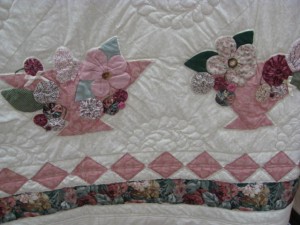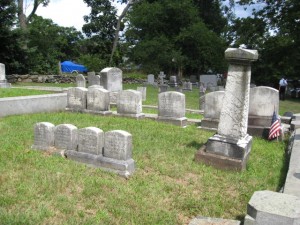If you are a regular or even occasional reader of my blog, you may remember that back in February, I wrote about the 200th birthday party for my town. Today we held another celebration of this milestone year with the Old Home Day Parade and other activities scheduled throughout the day. Due to the severe thunderstorms that passed through this area last night, we were all a bit anxious about the weather, but the lingering showers cleared by mid-morning and we were blessed with a fine late summer day.
At 10 am, I joined a small group for a short bus tour hosted by Eugene Caille. Though it wasn’t quite what I expected, I was fascinated by Gene’s discourse on North Brookfield’s history from the perspective of two immigrant groups, the French Canadians and the Irish, and their interactions through baseball. In our area and throughout New England immigrants were recruited to work on the railroads and in the factories spawned by the Industrial Revolution. In North Brookfield, the two groups lived mostly in their own parts of town, the Irish around Bell Hill and North Main Street, where they attended St Joseph’s Church, and the French Canadians in the neighborhood still known as Little Canada, low-lying swampier land alongside Grove Street. Millhands worked long hours and looked forward to their leisure time, and in fact, some of the conflicts between the ethnic groups continued in the baseball games they played, which often ended in brawls. Newspaper accounts of games might say, “Game curtailed due to altercation,” which probably meant that both the constable and the priest had been called to the field.
We parked for a bit adjacent to the playing fields:

This field was the site of a number of memorable games, including one played by the North Brookfield Armortreds against Connie Mack’s Athletics (the North Brookfield team won). North Brookfield sent at least one player to “the Show”: catcher Marty Bergen. Both Connie Mack and Broadway showman George M Cohan contributed to a headstone for Marty, who is buried with his family in St Joseph’s Cemetery.
At the beginning of the tour, Gene told us that he thinks about history in terms of “stories about people” which are woven into the fabric of the larger stories we tell about our communities and our nation. That is why he focused on the French and Irish immigrants and related what happened to them in the context of larger movements like industrialization and temperance. He also told us stories about two men from North Brookfield who participated in our country’s wars: one who fought at Antietam during the Civil War but was eventually executed for desertion, and the other who fought at the Battle of Bastogne in World War II. Both connect our town to pivotal events in our nation’s history, and both veterans deserve to be honored by our town.
At 11 am, the Parade began at the North Brookfield High School, at the junction of Routes 148 and 67, and marched south on Main Street to where I stood watching near its terminus at Hannaford Supermarket. I missed 98-year old William Minns leading the parade as Grand Marshall, but we saw all the rest of it — well, I don’t remember any marching bands, so maybe I missed these too. Note: If you click on this link now, you may need to hit your browser’s “back” button a couple of times to continue reading the post.
 |
| North Brookfield 200th Anniversary Parade |
Around noon, my friend and I were hungry, but there wasn’t much vegetarian fare for me at the food booths on the Church Common, so we crossed the street and and lunched at Subway. Good enough.
Next door to the sub shop is the Haston Library, the venue for a Quilt Show, which is where we headed next. I have done some quilting myself (well, I’ve made exactly two pieces), and I love fabric and needlework in general, so I was looking forward to seeing this exhibit. I wasn’t disappointed: I enjoyed learning about the history behind each quilt, and I also admired the craftsmanship, particularly of the hand-made pieces. On display was the 175th anniversary quilt, as well as this year’s 200th anniversary quilt:

I took photos of my two favorites. This one is appliqued:

And I liked this one because these colors appeal to me — I’m also a fan of strictly geometric design:

Local musicians entertained at the various venues. Here in the library, we listened to the Mill River String Quartet.

Our next stop was the Art Show, organized by local artist Elisabeth Hyder, in the conference room at the Police Station. All citizens were invited to submit art work, so there was a variety of pieces in various media on display, from photographs to collages to painting to sculpture. Rori Coakley and Hunter Foot, on piano and violin, entertained in this venue. Back on the Church Common, the Tequila Amigos Brass Band played.
At 2 pm, we walked quickly to the Maple Street Cemetery, where members of the local Boy Scout troop talked briefly about some of the prominent town citizens buried here (this cemetery is the oldest in town). I’ve walked by here many times but never really stopped to examine the headstones. No one is sure which is earliest dated grave, but we did see stones dating back to Revolutionary War times:

Due to weathering, some of the inscriptions have become hard to read, on both the granite and slate stones.
Back in the center of town, we stopped at the North Brookfield Historical Society Museum, but it was very crowded, so we didn’t try to get inside (the Museum is open on weekends anyway). Our last act of the day was to take our chances in a raffle held to benefit the Friends of the North Brookfield Town House, which is one of our town’s architectural treasures and in a terrible state of disrepair. I’m hoping one day to write a blog post about the grand re-opening of this iconic building.